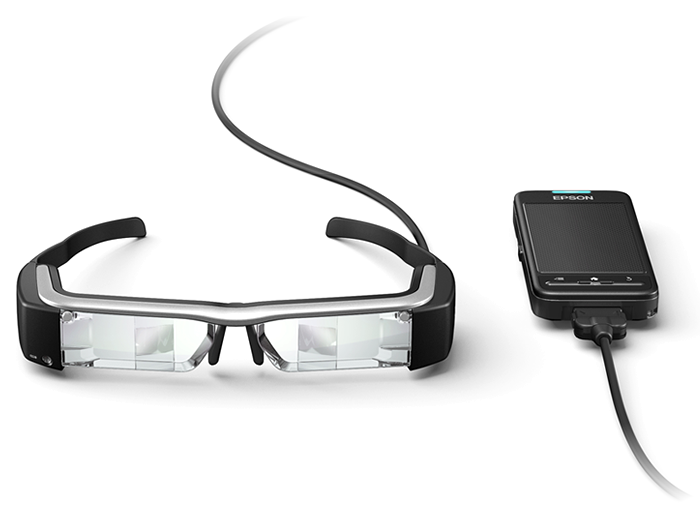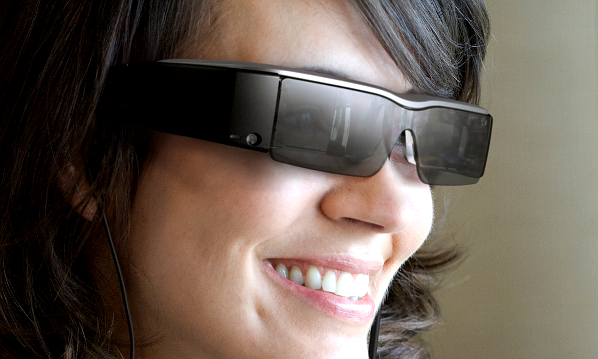Epson: Unlocking the potential of augmented reality today [Q&A]

Microsoft’s HoloLens, and the Google-backed Magic Leap might be touted as the future of augmented reality wearables, but electronics giant Epson has beaten both firms to the punch. Its own AR smart glasses are already on the market and finding an appreciative audience among gamers, movie watchers, businesses, and even the registered blind.
I spoke with Valerie Riffaud-Cangelosi. Epson’s New Market Development Manager, about the Japanese firm’s venture into augmented reality, and its plans for the future.
BN: What is the Moverio BT-200?
V R-C: The Moverio BT-200 is Epson’s second generation binocular, see-through smart glasses with AR capabilities. Key features include a front-facing camera and motion trackers, a "floating" 80-inch perceived screen, Wi-Fi and Bluetooth connectivity and an interactive track pad.
BN: Who is it aimed at?
V R-C: The Moverio BT-200 is both aimed at consumers and business users within multiple sectors.
Our smart glasses are great for entertainment purposes -- allowing the user to experience truly immersive, big screen gaming and cinematic viewing -- but within western Europe, we see their real potential lying in the business arena, leveraging their practical applications to enhance diagnostics, customer service and training.
BN: What is it being used for?
V R-C: Smart glasses have already established growing interest in the consumer market, but we believe that the real opportunity for wearable technology lies within the commercial and services markets, deployed to improve service provision and workplace efficiency through Augmented Reality. Our AR applications are used to increase productivity and efficiency for businesses in many different market sectors, from retail and tourism to education, healthcare, architecture, aviation, logistics and beyond.
For example, airline EasyJet is currently field testing Epson’s Moverio glasses to enable engineering teams to see exactly what a pilot or engineer is seeing remotely using AR technology, with the ultimate aim of minimizing passenger delays and improving its industry leading safety records. Currently, engineers and pilots have to email pictures and call EasyJet’s Operations Control Center (OCC) to try and resolve issues manually. With Moverio, EasyJet’s OCC can provide live information to the engineers and pilots in real time, along with technical assistance through the integrated hands-free head set.
Other companies are recognizing the opportunity of AR as a means of improving the customer experience, and speeding up the sales and decision process. Global flooring solutions company Tarkett, for example, has been using our smart glasses as a way of providing its customers with an immersive visualization tool for viewing different floor covering options by overlaying the image of the different products into 3D and real world views of rooms.
The process removes the need for customers -- mainly architects, designers and building owners -- to 'imagine' what a room would look like from viewing product samples or 2D computer renders. Instead the solution delivers an instant, immersive view and atmospheric representation, ultimately helping to ease the decision making process.
BN: Are they suitable for spectacle wearers?
V R-C: Absolutely, the Moverio BT-200 has a prescription lens insert, which allows users to mount their own lenses.
BN: What partners do you have working on applications, and what sort of products are they creating?
V R-C: Epson has established partnerships with numerous end user companies, ISVs and developers in order to create solutions and applications for use in fields from healthcare and dentistry to aviation and logistics.
To give you an example, Mekorot, a leading Israeli water distribution company has been using our Moverio products for remote field diagnostics and maintenance of their equipment. Working closely with Fieldbit, the ISV who developed the application for the project, our smart glasses are helping Mekorot to improve its business efficiency and productivity since its employees no longer need extensive training and can work on the equipment without having to handle papers or memorize a range of details.

BN: How does this compare to Microsoft HoloLens?
V R-C: There are numerous concept products and prototypes in circulation at the moment, and it would not be right for us to make comparisons or offer comment on them. Our product is one of only a few to have made it into mass production. This is due to the complexities of manufacturing the components needed within smart glasses -- particularly the optics. We have been able to achieve this because the technologies used within our product are all our own and have been used in other formats for many years. We also control our own production and are therefore able to adapt and respond as needed.
BN: Do you think we'll see more companies producing similar products, and how will Epson stay at the forefront?
V R-C: With businesses feeling the pressure to stay competitive, the AR market is set to explode. We have no doubt that other companies will want to capitalize on the growing demand for AR devices.
Our advantage is that all of our products and components are based on our core technologies and are manufactured in-house by Epson. Our heritage lies in sensing -- a key element within smart glasses -- as well as our 3LCD technology used in projection, which has been miniaturized for use in our smart glasses.
We never imitate others but create new technology solutions and products from the ground up. We have been listed as a top 100 innovator for the past three years by Thompson Reuters and we invest $1.3 million every day into R&D, resulting in around 5,000 patents being registered each year.
BN: How will smart glasses with augmented reality benefit our lives in the future?
V R-C: In the future, we can expect augmented reality to impact and improve many aspects of our lives, from healthcare through to education and industry.
One key example of how these products are already making a real impact on the lives of individuals and improving quality of life is the project underway with Oxford University. The team there are using the Moverio platform to develop a system to improve the vision of people who are registered blind. This project is a joint effort being progressed by multiple research departments within the university with a specific focus on mitigating some of the main challenges faced by partially sighted people. This includes helping to improve peoples’ ability to recognize faces and facial expressions -- a challenge that for many means that they struggle with some of the basic social cues and principles of social interaction. The system, which is now in field trials, is expected to be capable of significantly improving the vision of around half of those registered blind.

BN: What new trends in wearables are you seeing?
V R-C: There is currently a growing acceptance of wearable technology products as well as a desire to use technology to improve lifestyles, business and health.
With the emergence of trends such as Big Data and the Internet of Things, AR devices are further enabling sophisticated business application development, supported by more and more devices becoming connected and enhanced through sensing technologies. These sensing capabilities ultimately mean that AR devices will increasingly enable the input of, access to and output of vast amounts of data that can be provided in meaningful formats, successfully blending the analogue and digital worlds.
BN: Is Epson planning on developing more wearables in the future?
V R-C: Yes, wearable technologies are a key focus for Epson and draw from a number of our core strengths and technologies. At present, this business area is in its infancy for us, but we anticipate a material impact on profit to be generated within three years. By this point, we expect wearable products to represent a 10 billion yen business for us and within five years, this will have doubled to 20 billion yen.
Leveraging cloud and mobile technologies and their ability to give people access to data anywhere and at any time, our ultimate goal for the wearables sector is to produce products and platforms that can help improve quality of life.